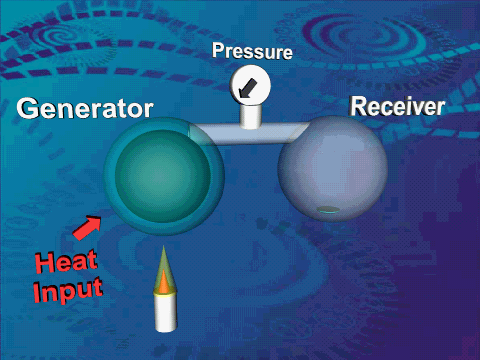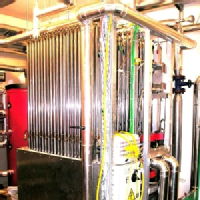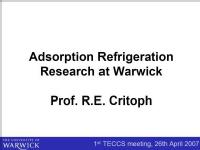Adsorption cycle
What is adsorption heat pumping?
An adsorption heat pump can be thought of as utilising a chemical rather than a mechanical compressor and is driven by heat rather than mechanical work.
Basic adsorption cycle

The operation of adsorption heat pumps and refrigerators is based on the ability of porous solids (the adsorbent) to adsorb vapour (the adsorbate or refrigerant) when at low temperature and to desorb it when heated. The most basic configuration for an adsorption refrigerator or heat pump is illustrated in the animation below.
This basic system is comprised of two linked containers, one of which contains the solid adsorbent and is termed the generator and the other is the combined evaporator and condenser or receiver in which the refrigerant is evaporated and condensed. Initially the system is at a low temperature and pressure and the adsorbent contains a high concentration of refrigerant, whilst the receiver contains only refrigerant gas.
The generator is then heated which causes refrigerant to be desorbed, raising the system pressure. Refrigerant condenses in the receiver, rejecting heat and producing a useful heat output if the system is to be used as a heat pump.
Cooling the generator back down to its initial temperature completes the cycle and causes the adsorbent to readsorb the refrigerant. The system pressure is reduced and the liquid refrigerant in the receiver evaporates, absorbing heat. This produces the useful cooling effect if the system is to be used as a refrigerator.
Although the heating and cooling provided by a single generator is discontinuous, it can be made continuous by operating two or more generators out of phase.
Advantages
Adsorption heat pumps utilise natural refrigerants such as water, ammonia or methanol, which have no harmful effects on the environment. They can also offer better utilisation of primary energy and be driven by waste heat or solar energy.
Challenges
The basic adsorption cycle has low efficiency, which requires methods for recovery of heat between adsorbent beds, and the inherently low thermal conductivity of available adsorbent materials results in low power densities and machines of high capital cost. Research work is focused on improving performance in these two main areas.


